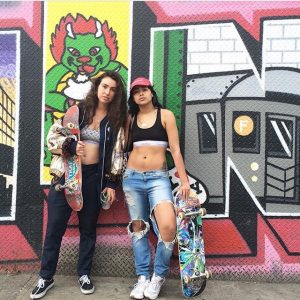
Lizzie Merrick
Cultures and countercultures, built of resilience, need and breathe their music, art forms, and styles. Art and individual authenticity, in the many forms they take and the many ways they reach us, make known the life force of the artist. This living and making of art show what is possible and true, and inspires others to embrace their identities with less shame and loneliness. Authenticity is a site of resistance, but is also quickly noticed and preyed upon by the forces that seek to commodify and exploit. The artists and individuals I am writing about in this project are aware of these forces, and have taken clear stances against the violence of processes such as gentrification, where communities are invaded, marginalized in their own neighborhoods, and have their culture stripped from them in the interest of capitalist profit-making. Princess Nokia and the members of BRUJAS, who I will discuss here, illustrate the experiences of people who do not fit within the ruling white cis-hetero capitalist patriarchal narrative. They empower and help youth to feel they may grow as part of a larger nurturing community, rather than in isolation.
These artists connect people to each other by way of their work, which acts as a tangible point of entry for conversations to be had, floors to dance on, where to sing, rap, skateboard. They are the music and food for the visions for strong and celebratory survival in a society ruled by structures, institutions, and people who would sooner erase than embrace those whose identities have been marked as other, deviant, or undesirable. Their work strengthens and gives life. By being present and audible and visible in their scenes, these individuals create community, dialogue, and spaces for youth, especially young women, femmes, gender non-conforming people, and people of color, and others who are always simultaneously invisibilized and hyper-visualized and sexualized, subjected to violence, and pushed to the side while having their identities and culture commodified and exploited. These individuals reclaim what dominating white-supremacist capitalist patriarchy culture has taken, made exclusive, inaccessible, and oppressive. They reclaim language and concepts that have been used to suppress, and they make community space for alienated bodies and voices. They and others, are role models and big sisters to so many.
BRUJAS
“Skateboarding is like flying. I could not be healthy without it.” –Arianna Gil (New York Times)

We never had the intention of speaking on behalf of all “BRUJAS” as they exist across historical and cultural landscapes… We believe everybody is entitled to their own interpretation and expression of resistance culture…we still have respect for people who honor tradition and heritage as their own resistance. Spanish was the first if not mutual language in the Lower East Side and Uptown for many of BRUJAS. …We continue this resistance by assigning old words new meanings, this is a part of dialectics, a part of the course of history. Projects like BRUJAS are the social and material response to the contradictions of capital, linguistic tradition, and epistemological process that moves history forward (BRUJAS).
Arianna Maya Gil, one of the founders of BRUJAS, says she chose to name the collective BRUJAS because the project is “about claiming our own powers—our own superpowers” (we are mitú). BRUJAS came from a desire to cultivate an alternative narrative to the male-dominated cis-hetero culture of skateboarding, particularly in New York City, where BRUJAS was founded. “Skateboarding,” said Arianna, “even though it has a very revolutionary energy—it’s very heteronormative, and very patriarchal. That, in a lot of ways, makes skateboarding less cool” (New York Times). As is the case with most sports, because of the way athleticism is designated to the “man/masculine” side of the gender binary, there is a huge need to shift the dynamics and culture of the skate scene to be more inclusive and offer more space to other gender identities.
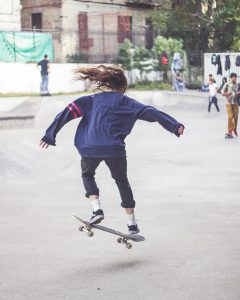
Community Building through Social Media
BRUJAS describe themselves as “a freeform, urban revolutionary feminist collective that expresses community through skateboarding and political organizing–mainly in the form of services and programming designed for urban youth of color” (BRUJAS). As they have become more well-known, they’ve utilized social media to state their intentions and to reach other girls and non-binary youth. A huge part of their impact has been self-publicizing their passion for skating online, and using those platforms to amplify a call for intersectional feminism, to create space for Latinx and other communities of color to be in sistership and solidarity, to have fun together, and project their own narratives and experiences to be heard and respected.
I think our objective with like using, like platforms is just to let other girls know that there’s people like them out there who are like you know confident and excited, knowing that there’s girls who come to that park, knowing that there’s girls who are proud of being girls, like wanna talk to other girls who aren’t just there to like do their own thing, but like have an intention of building community (we are mitú).

After BRUJAS had their first big media feature in a magazine called Browntourage in 2014, girls started coming in larger numbers to the skatepark, telling the collective that they had seen the article (BRUJAS). Through platforms like instagram, BRUJAS can also self-publicize, letting other kids know directly (without media gatekeepers) that there are girls like them out at the parks skating, being athletic, partying, having dialogue about social and political issues affecting them, and hanging out.
Parties, Workshops, Streetwear
Arianna explained that part of the BRUJAS project includes throwing parties to create “safe space for women to dance and socialize” (we are mitú). In the past two years, BRUJAS writes: “we have thrown over 25 parties at small clubs and apartments as well as large venues for our queer formals (Anti-Prom and Winter Informal). Our parties intend to create safe space where women and gender nonconforming people can take charge creatively.” The BRUJAS #DEATHTOALLMALELINEUPS campaign, launched in Summer 2016, has been “employing tactics of economic advocacy and creative support for young women and gnc musicians,” and overlaps with BRUJAS efforts to create move inclusive and accessible party culture (BRUJAS).

BRUJAS has also organized other events in the city, including a workshop on material feminism with Silvia Federici, and another on herbal medicine. In September 2016, BRUJAS also did a collaboration at the Museum of Modern Art called “Claim Space” with artist Zelijka Blaksic that “sought to tackle issues of accessibility in public space” (BRUJAS). In October 2016, BRUJAS launched an anti-prison streetwear line called “1971,” which has “allowed BRUJAS to establish a legal fund, raise awareness around ongoing prison strikes against slavery behind bars, as well as communicate our group’s position on prisons.” BRUJAS raised nearly $23,000 with these clothes, and this money will go to support those “facing criminalization and incarceration.” BRUJAS also has other fashion projects which you can find on their website as part of their mission to create clothes that “are the artistic representation of our gendered and political experience:
“While some may feel ok wearing skate brands and streetwear designed by men for companies run by men, we are personally unsatisfied by them and feel compelled to make alternatives in a world whose artistic representations continuously fail the queers and rebels” (BRUJAS).
State of the Union Salute & the Future of BRUJAS
BRUJAS are not afraid to talk about and confront systems of racial domination, power and exploitation, ever, or to admit our mistakes. We commit ourselves to being better co-conspirators for those most affected by white supremacy (BRUJAS).
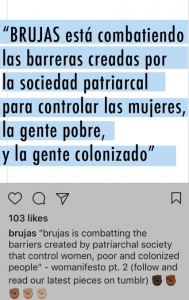
Recently, BRUJAS published a “State of the Union Salute,” discussing their origins, their accomplishments so far, and putting forth their ideas for the future of the project. The collective has plans to continue doing solidarity work and fundraising, workshops, and other endeavors.
We, as BRUJAS, encourage women’s participation in the creative economy. BRUJAS are harnessing the radical potential of lifestyle and personal branding to organize youth in a way that is culturally relevant and familiar, yet explicitly anti-capitalist. We are searching for a new popular model that is going to bring agency empowerment, material and emotional support to our community (BRUJAS).
BRUJAS plans to keep making clothes and developing “products that are intended for self-care and healing.” They plan to do so in collaboration with other women-run brands, by bringing business to local business, creating with “ethically principled companies working in the U.S with good labor practices and production standards,” while always reminding themselves of their “origins and intentions” (BRUJAS).
BRUJAS says that they draw inspiration from groups such as the Rainbow Coalition, the Young Patriots, the Young Lords, and the Black Panther Party. They write:
Our political work has and will continue to be about coalition building amongst difference. We have also been inspired by guidance from Silvia Federici who told us “I trust that when people begin to seriously organize they realize they cannot work on the basis of exclusionary politics.” We are harnessing our collective energy, regardless of identity, with the intentions of redistribution and reparations for all that have and will continue to be exploited and alienated under capitalism (BRUJAS).
BRUJAS shows how an art form such as skating can be used to bring people together and give rise to a multifaceted artistic, political, community of resilience, care, and fun, at parks, parties, and over the internet. BRUJAS resists the interlocking systems of white cis-hetero capitalist patriarchal oppression by creating a new culture of athleticism, artistry, and living, that is not exclusive of the wide range identities that exist. Remezcla, a Latin online newspaper, suggests that,
Perhaps the scariest thing about a bruja is the danger she poses to a male-dominated society. In a world of anti-Latinx, anti-queer, anti-woman, choosing to believe in the power that lives inside of these bodies is an act of resistance. To say one is a bruja is to believe in the agency taught through ancestry and know that among marginalized groups, there has always been magic, and it calls us to remember its beauty (Flores).

Those whose bodies do not conform seek others for community, and BRUJAS is an example of a project that brings women, femmes, and gender non-conforming youth together in a multi-cultural coalition to support one another, be joyful, and envision a safer, more inclusive world. By cultivating this culture and giving it a bold voice, BRUJAS makes this world more possible.
Princess Nokia
We have to realize that our zeitgeist relies on entertainment and art. We are all artists no matter how mainstream or underground you are. We are a society that has built it’s back and labor on black labor and black culture, on brown labor and brown culture, on urban realism, on the struggle of the oppressed, of the slave, of the native, of the indigenous, so we all represent something that is far bigger than us. – Princess Nokia (Hairston).
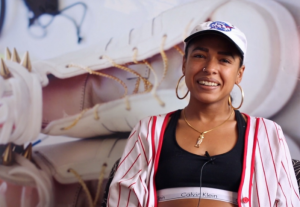
Destiny Frasqueri was born in New York City in 1992, and grew up in Harlem and the Lower East Side. She came out with her first song at 18 years old, and is now known by most as Princess Nokia (Snobette). In 2016 she released her debut album, 1992. Princess Nokia described her musical projects and her identity as powerfully tied to her growing up in NYC, and to her African and Puerto Rican heritage:
You know one day I’ll feel real tomboy, very new york, very raver, you know, very teenager, very low maintenance. One day I’ll feel very rustic and Native, and I’ll put my hair in braids and I’ll put feathers in my hair. I’m Black and Native. I like really incorporating those cultures into my style, because they’re beautiful cultures. They’re beautiful styles. When I look at myself, I don’t see myself as just a pretty girl, I don’t see myself as just a Brown girl, I see like the blood literally splitting into all these different lines of people and heritage (Snobette).
In interviews, Princess Nokia speaks about her understanding of the power of language and the way that forms such as rap, hip hop, and Afro-punk give the artist a performative platform from which to speak to the numbers and threaten dominant culture and its violent perpetuation of stereotypes and identity discrimination.
We can do a lot of things with words. Words are very powerful. It’s called spelling for a reason. You know? …Rappers, they shake people up… that honesty, that directness, that rawness, it could make people uncomfortable, it does. And I think that anytime a black, brown intellectual person really says something of true honesty that has scientific philosophic, esoteric, facts behind them, it make people scared because we are surpassing the stereotype that they think we are. Because we are truly philosophers, we are educated people (Galore TV).
Art resides in both the public and private, and makes its political impact in both. Princess Nokia’s work reaches young people wherever they are, through her music, her words, at her concerts, and on social media. Written in article about Princess Nokia in Impose magazine: “by simultaneously looking forward and honoring her roots, Nokia’s work feels vital at a time when internet-based conversations are shifting towards unpacking intersecting identity matrices” (Mashurova).
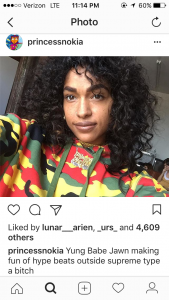
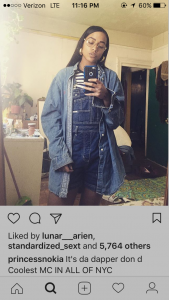
The Music
Princess Nokia’s musicianship is one of her most powerful forms. Her life and her art resist adherence to the oppressive, restrictive forces and structures which are potent in the music and creative arts, and the world we live in generally, much like they are in the skate culture BRUJAS confronts. When asked about the message she is striving to put out through her work, Destiny answered “I’m a smelly f****** kid and I love myself” (Galore TV). This answer encapsulates what makes her music and presence so important. Princess Nokia creates and performs fearlessly and with love for herself. Her authenticity is her resistance. One of the reasons that representation and role models are so necessary is that their visibility offers as an example of what is possible, and shows the embrace of what is beautiful but deemed undesirable in the mainstream.
In doing this project, I wanted to take space to talk about the messages in Princess Nokia’s music, but I realized that she and her work can and have spoken to that far better than I can analyze or dissect it. Still I want to highlight a few examples of her music here.
“Tomboy” is probably Princess Nokia’s most popular song, and she has spoken about it and music video as a depiction of her without her “eccentricism” (Galore TV). BRUJAS appear in the music video—Destiny is friends with members and they all grew up in the shared space of the city. Destiny’s music videos are very important to her work. The song “Brujas” is an example of the way her videos place Black and Brown women and femmes and their contemporary and historical culture at the front, allowing for self-representation without exploitation and exoticizing, since she and her friends exercise creative control over the projects. In “Mine,” Princess Nokia talks about hair, and how white women will non-consensually and inappropriately touch Black and Brown women’s hair, and disrespectfully engage with and inquire about cultural practices and concepts that they are ignorant about.
Many of Princess Nokia’s songs are about her life in the city, such as “Bart Simpson,” and “Green Line.” Destiny often talks about how her work is about “being the coolest person and ugliest person at the same time.” She says, “I like the duality of making something beautiful that isn’t supposed to. And its just like, I’m rapping now this is just who I am” (Galore TV). In society where white supremacy, racism, misogyny and trans-misogyny rule, and are the forces that create notions and rules about what is acceptable, beautiful, to be praised, and what, on the other hand is ugly, undesirable, impossible, and wrong, and to be punished, Princess Nokia manifests a visible, and accessible point for communities to begin to redefine narrow definitions of beauty, womanhood, sexuality, gender, desirability.
Social Media
Similarly to BRUJAS, Princess Nokia’s instagram allows her to have control over her image, in a way that makes her authentically visible to the public and makes for more direct and open communication between her and the people she inspires and acts as a role model for.
Fan art is sometimes submitted directly to Destiny, and she has posted a lot of it on her account, thanking the people who made it:
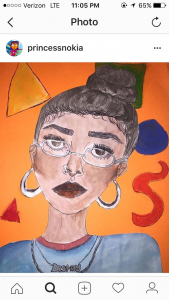
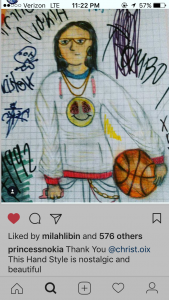

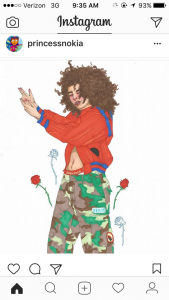
Concerts: Femmes to the Front – People of Color to the Front
Princess Nokia’s position both in the public realm and on stage gives her the opportunity to set an example and publicly distinguish between what is okay and what is not—to call out what is unacceptable, hateful behavior. At her shows, she brings women and people of color to the front of the audience, and makes clear that her concerts are spaces where sexual harassment, racism, and other forms of hate will not be tolerated. During a show in Paris, she announced loudly into the mic: “this is a safe space for black, brown, yellow and Arabic folk… so if you are a person of color, please make your way to the front, because your place is not in the back” (SURL).
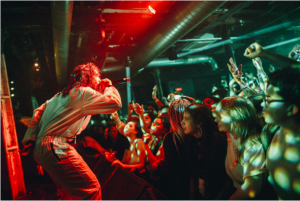
People gather at Princess Nokia’s concerts for music, but they are also settings where she can speak directly to the community and create a new world in the space. A her shows she encourages women and girls, people of color, people from areas of economic vulnerability, to embrace their identities and to acknowledge together that there are alternative stories than those imposed by dominant white cis patriarchal culture: “we are not just ghetto women. Yes we fab, we from the ghetto yes, but we fabulous, we educated, we well spoken we are accomplished we are full of accolades” (SURL).
Smart Girl Club
Destiny Frasqueri, along with her friend Milah Libin, founded Smart Girl Club, an urban feminist art collective that “aims to empower women of all shapes, sizes, colors, sexualities, and orientations by focusing on creative collaboration and celebration between women” (Smart Girl Club). Destiny said that she was inspired by her ex’s art collective and decided that she wanted to set up a supportive, creative group like this for women (Latino USA). In creating space for women of color, for engaging in real feminism that acknowledges the complex intersection of oppressed identities in order to provide support for those of the many different communities that need solidarity and protection, Smart Girl Club is a model of community and self-empowerment.
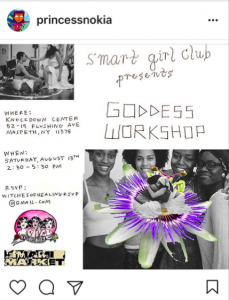
Smart Girl Club holds organized gatherings for women and femmes in the urban community to have political dialogue and to take education, political discussion into the hands of the community, outside of the realm of academia and intellectualism, which can be inaccessible and detached.
NYC and Gentrification
I think gentrification f****** sucks. I think it sucks for the people that have to live through it, through the entire process of it…there’s a new development of a highrise condominium being built in the middle of the projects, and all of a sudden the cost of produce has risen four dollars, it’s just, it’s uncomfortable, it’s uncomfortable, not okay, it makes people feel like they’re fuckin’ animals, like that they’re worth is nothing, and I feel like that a lot, I do, and I felt like that when I when I started seeing it in East Harlem ten years ago (Snobette).
In the Bronx, a recent study shows that 71% of the community is at risk of being displaced by gentrification, a phenomenon that is a problem in many different parts of NYC, as well as in many other regions of the country. An article on this study highlights main findings of the report: “low and moderate-income residents are being replaced by wealthier populations in walkable neighborhoods with good access to jobs. Many of these walkable, accessible neighborhoods are seeing a shift to more expensive housing…these residents are mostly people of color” (Conde).
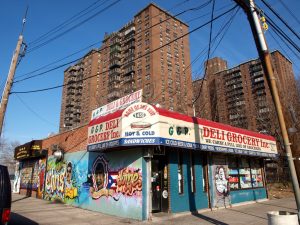
The artists and collectives I’m discussing were born and grew up in the Black and Brown NYC communities facing the most intense displacement of lower-income families and individuals, so they are not just aware of gentrification, they are directly impacted and feel the loss of culture and livelihood caused by it. Both Princess Nokia and BRUJAS have taken clear stances against these violent processes. In an interview Princess Nokia discussed her experience witnessing the transformation of neighborhoods in NYC over the years she has lived there, and the problems she has with it:
You know I’ve seen it in the lower east side where only the ghetto extends two avenues, that’s D and C, and then you’re pushing it. You know you’ve seen it in Brooklyn for a very long time now, which is the biggest um borough that we have. And um you know I don’t fuck with it. I’m very anti-gentirifcation, I’m very anti elitism, I’m very anti-smudging over this urban beauty that exists (Snobette).
In another interview, Destiny was also asked whether she thought that the influx of wealthier groups and populations into economically vulnerable communities made the neighborhoods safer. She responded “No I don’t,” explaining how gentrification means a larger presence of police who endanger Black and Brown men from the community and are “only trying to supply a safety to the people that have moved in, whose actual safety is at a premium, regardless” (Snobette).
Commodification of Counterculture
Authenticity is resistance to normative culture, but it also sets the conditions for the necessity of even more resistance, to the misogyny, racism, and exploitative means of the media. BRUJAS, in their recent “State of the Union Salute,” BRUJAS also speak to the way they have experienced the media’s attempts to commodify and exploitatively utilize the authentic culture of BRUJAS, because they know that a group of “skateboarding girls” is an the image that will sell:
Our experience with the media has demonstrated the dangers of encouraging things that lead women to accept their image as their primary source of value. The media is still misogynist in this respect. The media should only be covering things BRUJAS are DOING, because representation and existence is not enough at this point. Existence in a world built on slavery and colonialism is radical, but we feel organizing, when possible, is crucial. Placing our value on effort, talent, and facilitation is what will sustain BRUJAS beyond the media frenzy, and will continue our personal and collective growth in creative fields (BRUJAS).

As primarily women and femme skaters, BRUJAS faces much more exploitative media interaction, and are forced to be much more alert and defensive than their male counterparts when engaging with the media and who handles their image and words. Navigating the media is a part of preserving and defending culture.
Concluding…
Artists and role models mean different things to each of us, and matter politically to differing degrees, in different ways, for different communities. I was interested in learning more about the collectives and individuals I wrote about in this project because they inspire me, and are among the sources that help me, even now as a young adult, to embrace what I experienced of myself in the past as shameful, undesirable, and wrong. The way parts of us that deviate from what is the wobbly, unstable space called the “norm,” that hurts us and dictates punishment or reward, made me believe wholeheartedly at times, that I would always be alone and hiding.
I look up to these artists for their embrace of their own identities, their displays of self-love and pride in their passions and work, and I wish they had been visible to me when I was in elementary, middle, and high school, struggling with the many parts of my identity. For many, like femmes of color, these black and brown role models mean even more, and mean differently. As a white person, I can’t speak to what it is like for a person of color to see a Latinx collective or an African-Puerto Rican musician embracing their racial identities and passions as resistance to systemic and structural violence. The impact of these artists can be felt by us all, and can help us so much from their work and their lives, and their commitment to being themselves in this world that tries to crush the authenticity of our souls.

Thank you girls, for being my greatest supporters, for being the women who are vulnerable, and emotional, and beautiful, and hurt. I know we are all going through something. Trust me I always tell the women, don’t idolize me-I’m just like you. However, I make the discussion open, and y’all allow me to be your big sister, so then I will take that role. I love my little sisters very much, very, very much. Some of us speak different languages, some are from different places, but I think that, baby, the message is very clear that we are very strong, we are very deserving, we fucking kill shit – Princess Nokia, 2017
Sources
BRUJAS. (2017).
Conde, Ed García (2017, March 30). Startling New Report Indicates 71% of Bronx at Risk for Displacement—The Highest in New York Region. Welcome2TheBronx.
Flores, Andie (2017, March 1). Why Young Culture Makers Are Proudly Reclaiming Bruja Feminism. Remezcla.
Frasqueri, Destiny, and Milah Libin. Smart Girl Club.
Galore TV (2017 January 11). Couch Talk: Ab-Soul + Princess Nokia on Femininity in Hip Hop [Video file].
Hairston, Tahirah (2016, July 12). Afro-Latina rapper Princess Nokia on police brutality, identity and humor. Fusion.
Latino USA (2015, June 19). Smart Girls Club. NPR. [Podcast].
Mashurova, Nina. A Walk Through Zion with Princess Nokia. Impose Magazine.
New York Times (2016, July 20). Brujas of the Bronx [Video file].
Snobette (2016, July 18). Princess Nokia: “Everything is Based on Intention.” [Video File].
Snobette (2016, July 18). Princess Nokia: “No One Ever Asks Male Rappers, ‘What Do You Think of Female Hip-Hop?’” [Video File].
Snobette (2016, July 18). Princess Nokia: “There’s No Money in Record Deals & I’m Not Looking to Be Taken Advantage of” [Video File].
SURL (2017, February 4). Princess Nokia – Big Sister (2017) [Video File].
we are mitú (2015, November 11) Las Brujas – mitú [Video File].